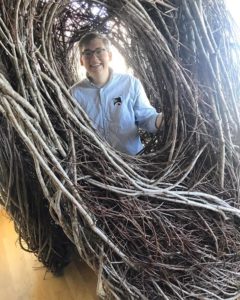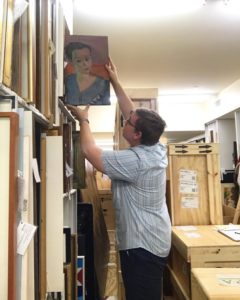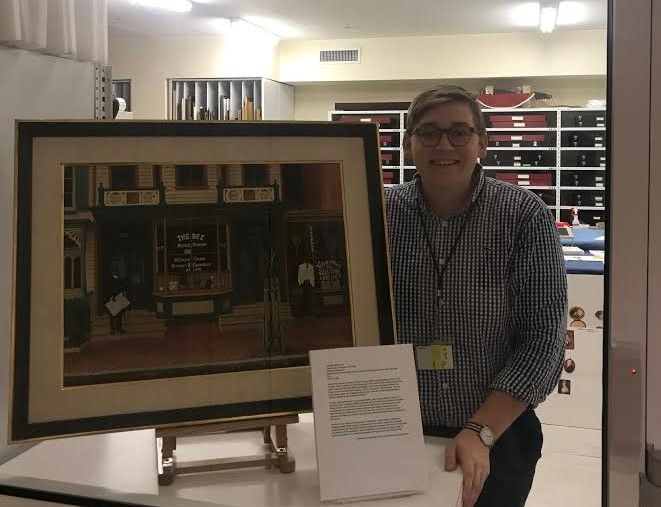Over the summer, the Curatorial and Collections department was fortunate to have Charlie Flynn, a rising junior at the University of Virginia as an intern for the department. Charlie assisted staff with everything from permanent collection rotations and processing new acquisitions, to writing content for the Museum’s mobile app and updating information in the collections database. In this week’s blog post, Charlie shares his insights into his time and experience here at the Gibbes!
For the past few months, I have had the opportunity to live in and explore Charleston while working as an intern for the Gibbes’ Collections and Curatorial departments. In searching for an interesting and constructive way to spend the summer following my second year at the University of Virginia, I learned about this opportunity at the Gibbes, and it seemed like a perfect fit. As a double major in Art History and American Studies, I was struck by the Gibbes’ commitment to both telling the story of Charleston and showing some of the south’s greatest works of art. I spent my second year in Charlottesville as an intern in the Fralin Museum of Art’s education department, which prompted me to think regularly about the museum’s role as a member of the community and an interpreter of history. Coming to Charleston, I was especially excited to learn about how the Gibbes inhabits these roles in a city with an especially complex and difficult history.

While I’ve become well acquainted with just about every department at the Gibbes, the bulk of my time has been spent with the Collections and Curatorial departments. I’ve really enjoyed working in Collections, especially as I’ve come to appreciate how much effort goes into the behind-the-scenes operations of a museum, as exemplified by Zinnia Willits, Director of Operations and Collections. One of my first tasks this summer was to cross check the pieces on display with their listed locations in PastPerfect, the museum’s collection database. This task was a great way to learn the program and a very rewarding way to get to know the museum’s permanent collection – and it was easy enough…until I reached the miniatures gallery!
I’ve also been able to spend a good amount of time working directly with objects in the Gibbes’ collections storage. I’ve developed an index of storage locations, examined and tagged new acquisitions, and spent perhaps too much time looking at the collection up close. This has all been under the watchful eye of the museum’s very talented Chief Preparator Chris Pelletier, who is always good for a laugh (or a history podcast recommendation). It’s been fascinating to get an up-close look at the methodology and careful planning that goes into safe, responsible art storage. One especially rewarding undertaking was working with one of the Gibbes’ newest acquisitions, Jonathan Green’s The Boat Men. I was responsible for creating a thorough condition report, tagging the painting with an ID number, finding a place for it in storage, and creating a file for it in PastPerfect. While this was interesting work in and of itself, there is also something thrilling about knowing that my mark will be permanently left on this painting.
I’ve also found a home in the Gibbes’ Curatorial department this summer, working closely with Sara Arnold, Director of Curatorial Affairs, and Amanda Breen, Assistant Curator. One of our main focuses has been on the upcoming permanent collection change out, which will put new objects on display throughout the museum. The miniature portrait gallery was a specific focus of mine. I was given the opportunity to select which of the miniature photographs would be put on display, which was more challenging than I anticipated. Rather than simply choosing the photographs that I enjoyed, I had to account for some practical concerns as well: are these photographs (some nearly 150 years old) in good enough condition to go on display? Will they all fit in the display case? Do these selections show a wide enough variety of early photography methods? Do they look good together? While this process was time-consuming, it was incredibly rewarding, and I’m very excited to see how they’ll look on display.

I was told early in the summer that I would be able to fill one of the on-site display windows with a painting of my choosing. While I was drawn many of the Gibbes’ pieces, I was especially fond of Robert Sivard’s 1976 painting, The Bee – 1900. The piece initially struck me with crisp, warm, even nostalgic colors and an attention to architectural detail. After doing some further research, I discovered not only that the painting was set in Washington, D.C. (a city I love as a resident of its suburbs), but also that it aimed to tell an little-known but very important story and pose questions about a city’s responsibility of preserving its history. The more I researched this piece, the clearer it became that it would be my choice for display. Seeing it in the window and watching visitors look closely at both the painting and my writing is an incredible feeling, and has only made me even more confident that a career in museums is something I want to pursue.
I’ve had the best time working at the Gibbes, and am so grateful to have had the opportunity to grow, learn, think, and explore this summer. While I can’t say that I will miss the humidity of Charleston in July, I will certainly miss the Gibbes and all of the people who have made my time here so special.
-By Charlie Flynn, guest blogger and Curatorial and Collections intern
Published July 26, 2019
Top image: Charlie Flynn with The Bee by Robert Sivard in Collections Storage at the Gibbes

